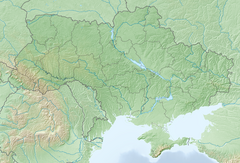Ukrainian T-shaped Radio telescope, second modification


 Related media on Commons
Related media on CommonsThe Ukrainian T-shaped Radio telescope, second modification (official abbreviation UTR-2) is the world's largest low-frequency radio telescope at decametre wavelengths. It was completed in 1972 near the village of Hrakovo (49°38′N 36°56′E / 49.633°N 36.933°E / 49.633; 36.933), 15 km west-south-west from Shevchenkove, Ukraine. The telescope is operated by the Institute of Radio Astronomy of the Ukrainian Academy of Sciences.



The UTR-2 consists of an array of 2040 dipole elements in two arms each containing 6 rows of elements, oriented in a T shape: a north–south arm consisting of 1440 elements covering an area of 1800×60 meters, and an east–west arm consisting of 600 elements covering an area of 900×60 meters. The basic element is a broadband cage dipole 1.8 m in diameter and 8 m long made of galvanized steel wire, mounted 3.5 m above the ground, with a balun to connect it to the transmission line. The dipoles are all oriented along the east–west axis, with the spacing between rows of 7.5 m in east–west direction and 9 m in north–south. It has a total area of 150,000 square metres (1,600,000 sq ft), and a resolution of about 40 arcminutes at the middle frequency 16.7 MHz. The operating frequency range is 8–33 MHz. The sensitivity is about 10 mJy.
Steering of the antenna main lobe is accomplished with phase shifters consisting of switchable delay lines.
The telescope is a part of the URAN (Ukrainian Radio Interferometer of NASU) decametric VLBI system, which includes another four significantly smaller low-frequency radio telescopes. That system has bases from 40 to 900 km (25 to 960 mi).
The telescope was seriously damaged during 2022 Russian invasion of Ukraine, the observatory's measuring complex and scientific equipment (but not the antennas) were completely destroyed.[1][2]
See also
References
- ^ "Під час окупації Волохового Яру на Харківщині було пошкоджено найбільший у світі радіотелескоп декаметрових хвиль УТР-2". Інтерфакс-Україна (in Ukrainian). Retrieved 2022-10-28.
- ^ Stone, Richard (2022-12-07). "Hero City". Science. American Association for the Advancement of Science. Retrieved 2022-12-10.
External links
- Institute of Radio Astronomy of the National Academy of Sciences of Ukraine [1]
- Braude, S. Ia.; Megn, A. V.; Riabov, B. P.; Sharykin, N. K.; Zhuk, I. N., Decametric survey of discrete sources in the Northern sky. I - The UTR-2 radio telescope: Experimental techniques and data processing, Astrophys. and Space Sci., 54, 3–36, 1978
- URAN-3 radio interferometer antenna field (abandoned)
- A. Konovalenko, L. Sodin, V. Zakharenko, P. Zarka, O. Ulyanov, M. Sidorchuk, S. Stepkin, P. Tokarsky et al. The modern radio astronomy network in Ukraine: UTR-2, URAN and GURT, Experimental Astronomy, Vol. 42, Is. 1, pp 11–48.
- v
- t
- e
- Units (watt and jansky)
- Radio telescope (Radio window)
- Astronomical interferometer (History)
- Very Long Baseline Interferometry (VLBI)
- Astronomical radio source
(List)
- Algonquin Radio Observatory (Canada)
- Arecibo Observatory (Puerto Rico, US)
- Green Bank Observatory (US)
- Haystack Observatory (US)
- Jodrell Bank Observatory (UK)
- Mullard Radio Astronomy Observatory (UK)
- National Radio Astronomy Observatory (US)
- Nançay Radio Observatory (France)
- Onsala Space Observatory (Sweden)
- Pushchino Radio Astronomy Observatory (PRAO ASC LPI, Russia)
- Special Astrophysical Observatory of the Russian Academy of Science (SAORAS, Russia)
- Vermilion River Observatory (US)
- DRAO (Canada)
- ESA New Norcia (Australia)
- PARL (Canada)
- Elizabeth Alexander
- John G. Bolton
- Edward George Bowen
- Ronald Bracewell
- Jocelyn Bell Burnell
- Arthur Covington
- Nan Dieter-Conklin
- Frank Drake
- Cyril Hazard
- Antony Hewish
- Sebastian von Hoerner
- Karl Guthe Jansky
- Kenneth Kellermann
- Frank J. Kerr
- John D. Kraus
- Bernard Lovell
- Christiaan Alexander Muller
- Jan Oort
- Joseph Lade Pawsey
- Ruby Payne-Scott
- Arno Penzias
- Grote Reber
- Martin Ryle
- Govind Swarup
- Gart Westerhout
- Paul Wild
- Robert Wilson
EM methods
 Category
Category Commons
Commons










